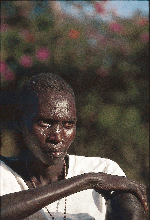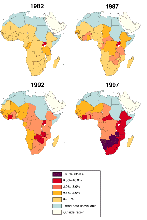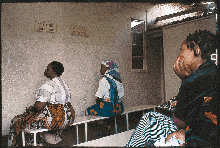
Ground Zero: AIDS Research in Africa
Jon Cohen*
Photos by Malcolm Linton
Scientists have stepped up efforts against HIV at the epicenter of the epidemic, as the virus continues to exact a growing toll in human lives
On a clear and cheery rain-washed March morning in Kampala, Uganda, Rose Busingye, an AIDS social worker and nurse, leads four visiting Italian AIDS researchers on a dark and depressing tour that begins at an orphanage. "They have no one," Busingye explains as she walks through the well-kept house that serves as the new home for a dozen children whose parents recently died from AIDS. She introduces a boy whose mother, a prostitute, hanged herself when she learned that her blood test for HIV was positive. A girl walks by whom Busingye had found wrapped in her dead mother's arms. Busingye points to siblings the orphanage found eating from a garbage pile.

The tour proceeds to Namuongo, a nearby village, where Meeting Point, the group Busingye works with, provides care and support for several people near death from AIDS. The researchers walk through fields of sugarcane, jackfruit, and yams, arriving at a cinderblock home with a corrugated tin roof. Inside, a 36-year-old woman, who has tuberculosis and the disorientation typical of AIDS dementia, is bedridden in a dark, two-room space she shares with her brother, his wife, and four children. She has been in this bed, a thin mattress on the floor, for 3 weeks now. "I'm not OK," says the woman, who has a large red Bible by her side.

The last stop on the 3-hour tour is Kireka, a poor village that abuts a rock quarry. Packs of children roam the small slum, which has rows of huts made from mud, sticks, and straw. Busingye says 40 of these children have lost both parents--either because of AIDS or the civil wars here and in neighboring Rwanda--and now are cared for by extended family. One orphan with withered limbs, who himself has late-stage AIDS and is wearing nothing but a long-sleeved pink turtleneck, takes the hand of an Italian AIDS researcher and walks with her. Meeting Point helps 120 AIDS patients in Kireka, including a 32-year-old mother of two who lies on the ground in the village's marketplace selling vegetables. Her husband died from AIDS in December 1998. "He had another woman," she explains. Now she has AIDS, as does her 15-year-old son.
Mario Clerici, a leading AIDS immunologist from the University of Milan, purses his lips and shakes his head. "All AIDS researchers should come here to see what AIDS is," Clerici says. "Most AIDS researchers have barely seen AIDS patients. Here, you see how horrible it is." Clerici holds up a hand and rubs his fingers together. "Come here and you can touch it."
More and more European and North American AIDS researchers are now coming to Uganda and other countries in sub-Saharan Africa, which is home to an estimated 24.5 million HIV-infected people--a whopping 70% of the global total, even though this region has a mere 10% of the world's population. Like Clerici, these investigators are not simply coming to see the epidemic at its center, but to collaborate with local researchers on projects that aim to slow both HIV's spread and the course of disease in the millions already infected. "There really is an expansion, I'd even say an explosion, over the last few years of AIDS projects in Africa," says Peter Piot, an epidemiologist who did pioneering AIDS research on the continent in the early 1980s and is now director of UNAIDS, the Joint United Nations Programme on HIV/AIDS.
But even with this explosion of research, the amount spent on African studies is a fraction of the total devoted to efforts in developed countries. Most cash-strapped African countries also spend little on research themselves, relying instead on the generosity of foreign collaborators, which inevitably raises tricky questions about research direction, control, and credit. More troubling still, most African countries--constrained by limited resources, weak infrastructures, social mores, and political inaction--have grave difficulties translating research insights into prevention and treatment strategies. "It's slower than anyone would like," says Dorothy Mbori-Ngacha, a pediatrician at the University of Nairobi who studies ways to thwart the transmission of HIV from mother to child. "You can do very good work, and it can end up not changing anything if you can't package it in a way that policy-makers can use it. We have quite a lot of research sitting on shelves."
From 9 to 14 July, the world's attention will focus on these and other HIV dilemmas faced by African countries, as thousands of researchers gather in Durban, South Africa, for their biannual international conference. Many Africans have high hopes that the XIII International AIDS Conference, the first ever held on this continent--or in any developing country--will live up to its motto and "break the silence" that, as chair Hoosen Coovadia put it in a welcoming note to delegates, "prevails across nations estranged by colossal inequities."
The modern plague
The surge of interest in African AIDS research mirrors the surge in HIV itself. As the World Bank noted in an unusually impassioned June 1999 report, "Intensifying Action Against HIV/AIDS in Africa," only one African country had an HIV prevalence rate in adults higher than 2% in 1982. By 1998, UNAIDS estimates, HIV had infected more than 7% of the adults living in 21 African countries, and in two populations a staggering 25% were infected (see maps). "Intensifying Action" also stresses that the African death toll from HIV--which is transmitted by heterosexual sex in 90% of the cases--soon will eclipse the 20 million Europeans killed during the 14th century plague.
Although hot debates continue to surround the question of how and when HIV entered humans and began its spread around the world, several compelling studies suggest it is a variant of viruses that infect nonhuman primates in central Africa (see p. 2164). The oldest HIV sample, which comes from the Democratic Republic of Congo (formerly Zaire), dates back to 1959, but most researchers suspect that AIDS had been killing humans for many decades--if not centuries--before that.
UNAIDS has the best documented estimates of the current prevalence of HIV and AIDS, but even these numbers are squishy. Bernhard Schwartländer, the UNAIDS epidemiologist who heads the department that provides the estimates, notes that researchers derive the numbers by extrapolating from "sentinel" populations, such as pregnant women who come to clinics. "We're more and more confident of our estimates we're giving year after year, but there's an order of magnitude of uncertainty that we have to deal with," says Schwartländer. Indeed, the HIV/AIDS estimates that UNAIDS will release later this week will have plus-or-minus values for the first time. (The global total living with HIV, for example, is 34.3 million ± 25%.)

Rare treats. University of Milan immunologist Mario Clerici carted candy from Italy to sweeten the day of children at an orphanage in Gulu, Uganda.
The figures portend a grim future: Because of the long time lag between infection and disease, sub-Saharan Africa has only just begun to suffer the full brunt of the devastation AIDS ultimately will cause. "The most disturbing long-term feature of the HIV/AIDS epidemic is its impact on life expectancy, making HIV an unprecedented catastrophe in the world's history," "Intensifying Action" concludes. "HIV/AIDS has already reversed 30 years of hard-won social progress in some countries. Now is the time for Africa--and the world--to fight back."

Benchmark science. A long-standing Nairobi clinic for sex workers has provided a model mix of prevention, treatment, and research.
Fighting back
Finally, the World Bank, governments, industry, and nonprofit organizations have woken up to this unfolding disaster and are stepping up the fight against HIV/AIDS in Africa. "We have a fantastic opportunity now," says Michel Pletschette, a European Commission official who oversees funding of AIDS research in Africa. "There's more will to do more. But it's a little bit sad to see we had to come to a situation where AIDS has a mortality equal to plague in the Middle Ages. If all these people were dying in a week, you'd see things differently than when they die in 10 years."
Attention to Africa's AIDS problems gained momentum in May 1999 when the South African government, in collaboration with the electrical company Eskom, pledged $8 million to support the newly formed South African AIDS Vaccine Initiative, which will fund R&D. Later that month, Bristol-Myers Squibb, maker of two anti-HIV drugs, launched "Secure the Future," a $100 million program to help five countries in southern Africa combat AIDS; it has already helped build a $5 million lab in Botswana to study drug resistance. A few weeks later, the Bill and Melinda Gates Foundation made a $25 million donation to the International AIDS Vaccine Initiative, which now is supporting R&D on four vaccines tailor-made for Uganda, Kenya, and South Africa. And international media are also paying attention: In November and December, the Village Voice, a free weekly paper based in New York City, ran reporter Mark Schoofs's remarkable eight-part series on AIDS in Africa, which later won the Pulitzer Prize.

Bleak projections. Adult deaths from infectious diseases in developing countries.
SOURCE: WORLD BANK
This year's U.S. budget includes a $100 million program, the Leadership and Investment in Fighting an Epidemic (LIFE) initiative, that aims to slow the transmission of HIV in sub-Saharan Africa, improve treatment for infected people, and provide care for AIDS orphans. In a January speech during the United Nations (U.N.) Security Council session on AIDS in Africa, Vice President Al Gore declared that "we are putting the AIDS crisis at the top of the world's security agenda" and pledged that the Clinton Administration would ask for an additional $150 million in the 2001 budget to fight AIDS in Africa. Pfizer Inc. announced in April that it would donate the antifungal fluconazole, an effective treatment for cryptococcal meningitis--a lethal, opportunistic infection of AIDS--to poor South Africans. A few weeks later, World Bank president James Wolfensohn declared that the bank will place "no limit" on the amount it spends on AIDS. "I have said to our African clients, if you have programs, we'll fund them," Wolfensohn declared. On 10 May, Clinton issued an executive order that relaxes U.S. laws regarding intellectual property rights connected to anti-HIV drugs in sub-Saharan Africa, effectively allowing countries to manufacture or import drugs without fear of violating patent law. Five pharmaceutical companies immediately promised to slash prices of their anti-HIV drugs sold in the region.
| LIVING WITH HIV/AIDS |
|---|
| Region | Number
infected* |
|---|
| North America | 890,000 |
| Caribbean | 330,000 |
| Latin America | 1.4 M |
| Western Europe | 500,000 |
North Africa and
Middle East | 210,000 |
| Sub-Saharan Africa | 22.5 M |
Eastern Europe and
Central Asia | 560,000 |
| Southeast Asia | 6.7 M |
Australia and
New Zealand | 12,000 |
| TOTAL | 33.4 M |
|---|
*
AS OF END OF 1998.
SOURCE: UNAIDS
On top of these commitments, several groups have donated money to help Africans take advantage of arguably the most meaningful advance yet made by AIDS researchers: the finding that relatively cheap, short courses of anti-HIV drugs can slow transmission of HIV from mother to child. With help from the Turner Foundation, the United Nations Children's Fund has started pilot studies of such interventions in eight countries in sub-Saharan Africa. France, aided by Glaxo Wellcome (which markets three anti-HIV drugs), last year started a similar program in Côte d'Ivoire called the Fund for International Therapeutic Solidarity. More support for drugs to thwart mother-to-infant transmission came in March from the Pediatric AIDS Foundation, which announced that it will award $800,000 in grants to seven programs in five African countries.
As sorely as Africa needs this assistance, it will have only a modest impact on the continent's AIDS crisis in the immediate future. "Every war needs a war chest, but that provided by the international community is woefully empty," Wolfensohn told the U.N. Security Council in January. Wolfensohn pointed out that Africa receives a mere $160 million now for HIV prevention; the bank estimates that Africa needs between $1 billion and $2.3 billion.
Public health experts stress that money is only part of the equation. Richard Feachem, director of the Institute of Global Health--a joint program of the University of California, San Francisco, and UC Berkeley--contends that African governments themselves have responded "halfheartedly" at best to their AIDS problems. Too many leaders, he says, have exhibited "ostrich behavior," have been "sitting on their hands," or have even actively made the situation worse. "If you liken this to a war, there are countries under attack losing huge numbers of individuals and doing nothing to defend themselves," says Feachem, an epidemiologist who formerly was dean of the London School of Hygiene and Tropical Medicine and an official at the World Bank. "In the absence of an effective government response, it's very difficult for others to get going."
Feachem, who has worked extensively in sub-Saharan Africa, has what he calls "a stock list of no-brainers" for governments: Educate the citizenry, provide condoms, clean the blood supply, work intensively with high-risk groups, provide early treatment for sexually transmitted diseases, and adequately train health providers. And he cautions researchers not to become "mesmerized by microdecisions," particularly when it comes to treatment options. "People can argue in Durban for days and days about what drugs to use and how, but if they return to countries that are not mobilized for war, anything they do will be trivial," says Feachem.
With similar impatience, Kevin DeCock, an AIDS epidemiologist with the U.S. Centers for Disease Control and Prevention in Atlanta who in 1988 started a large AIDS research program in Côte d'Ivoire, says that "the cost of the drugs is the least of the issues." DeCock, who's now based in Kenya, believes prices will fall, and says many international companies working in Africa already can afford to subsidize treatment for their workers. But African countries can't easily identify HIV-infected people and provide them anti-HIV drugs, which require intensive treatment regimens. "We could end up spending a lot of money with very little benefit," says DeCock. But he adds that "if the benefits of treatment are sustained in developed countries, it's increasingly going to dominate discussion."
To the front
No quick fixes will rescue Africa from the epidemic of HIV and AIDS that's already filling graveyards, crippling economies, and leaving legions of children to grow up parentless. But research does hold out the hope of, at the very least, optimizing the battle plans and, at the very best, forging the weapons themselves.
There are risks, however, in increasing research in sub-Saharan Africa, a region that for centuries has seemed to trade in one woe for another. For one, researchers themselves face danger; they operate on the front line, and an eruption of warfare can put lives in peril or destroy years of work overnight. Major AIDS research projects in the former Zaire, Rwanda, Sierra Leone, and Guinea-Bissau came to a sudden end because of civil wars. A coup took place last year in Côte d'Ivoire, northern Uganda remains embroiled in civil conflict, Zimbabwe has had deadly confrontations between poor blacks and wealthy white landowners, and Ethiopia and Eritrea are at war again. Although AIDS research projects continue in these locations, the investigators must keep a watchful eye on the political winds.
In peaceful areas there are other obstacles to overcome, such as the legacy of mistrust left by some past scientific studies. "To a large extent, colonial powers asked research questions that closely mimicked questions of interest in their country of origin," says Malegapuru William Makgoba, head of South Africa's Medical Research Council. "In the old paradigm, people did research without explaining to people why it was good for them, and usually it was best not for participants but for researchers. Now it's incumbent on researchers to do research in a very different way and to make sure it's applied and relevant to [African] society."
Translating research, ethics, the cost of drugs, politics, the spread of HIV, and the inexorably increasing toll of the AIDS epidemic all will receive a thorough airing at the 5-day Durban meeting that will take place 2 weeks from now. The 12 international conferences that have preceded this one focused largely on the concerns of wealthy countries. But HIV's impact on Africa surely will take center stage in this gathering.
Echoing the reaction of Milan's Clerici to the bleak morning tour in Uganda, UNAIDS director Piot thinks South Africa's intense epidemic of HIV will offer visiting delegates from developed countries their first chance to connect the mind-boggling statistics to individuals, communities, and a devastated society. (New figures suggest nearly a quarter of the country's adults are infected with HIV.) "I hope the conference will attract the brightest scientists in the West, so they'll be confronted with the real AIDS epidemic," says Piot. "Whether you do sophisticated molecular biology or research with the latest antiretrovirals, I think it's really important that you get a sense of what the epidemic is all about and where it's going. I can't see how you can work on AIDS without having a burning curiosity to see what's going on where the epidemic is today."
* Jon Cohen was accompanied by photographer Malcolm Linton. For a gallery of additional photos and the stories behind them, see
www.sciencemag.org/feature/data/aids_africa/gallery.shl.
Volume 288,
Number 5474,
Issue of 23 Jun 2000,
pp. 2150-2153.
Copyright © 2000 by The American Association for the Advancement of Science.
|




